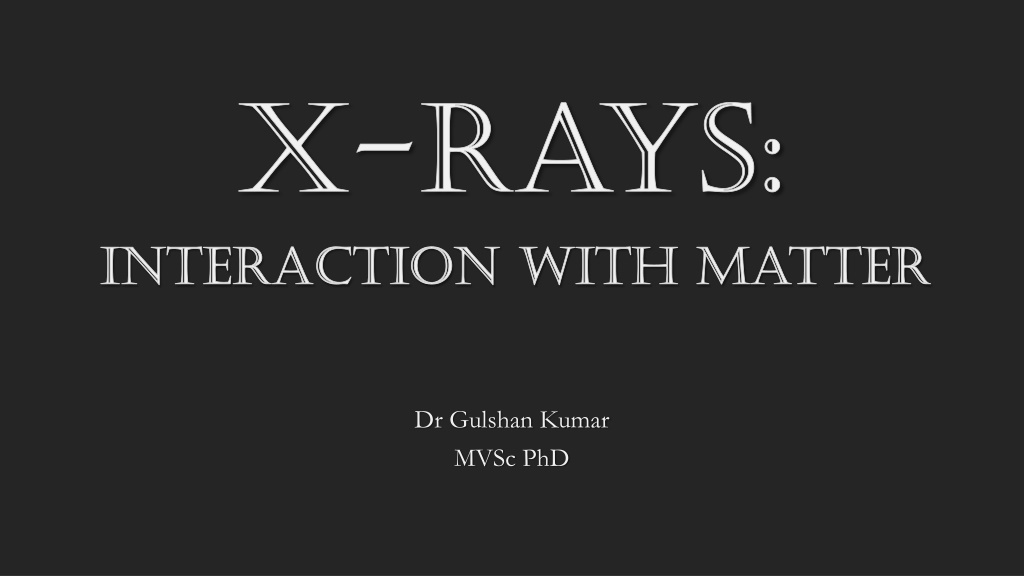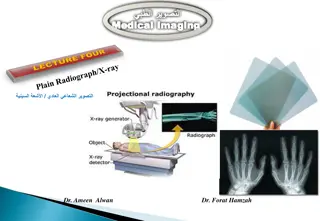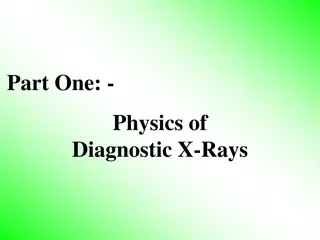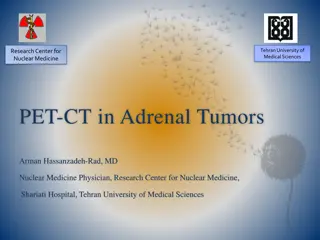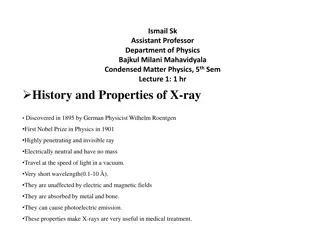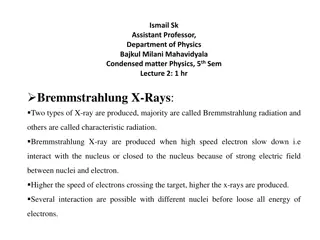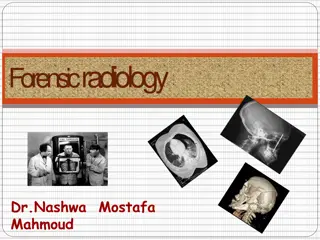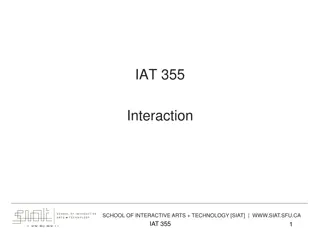Understanding X-rays: Interaction with Matter in Diagnostic Imaging
X-rays, being photons traveling at the speed of light, interact with matter in various ways such as Coherent Scatter, Compton Scatter, Photoelectric Effect/Absorption, Pair Production, and Photodisintegration. These interactions involve exciting atoms, ionization, and energy transfer, influencing the resulting image formation in diagnostic radiology.
Download Presentation

Please find below an Image/Link to download the presentation.
The content on the website is provided AS IS for your information and personal use only. It may not be sold, licensed, or shared on other websites without obtaining consent from the author. Download presentation by click this link. If you encounter any issues during the download, it is possible that the publisher has removed the file from their server.
E N D
Presentation Transcript
X-rays: Interaction with matter Dr Gulshan Kumar MVSc PhD
X-rays are actually photons travelling with the speed of light. Interaction.. How a photon interacts with matter on which it falls/impinges. Matter may be tissue/cells/or non-biological material (here, we are considered with biological material only). When the photon falls/strikes/impinges on the matter it encounters the atoms of that matter. An atom comprises of a nucleus containing neutrons and protons around which are several orbits in which electrons are arranged (2n )
When x-ray photons enter the matter, they may: Penetrate the matter, Get absorbed in the matter, or May get deviated and attenuated. So
X-rays photons may interact with matter in five (05) ways: Coherent Scatter Compton Scatter Photoelectric effect/absorption Pair production Photodisintegration
Coherent Scatter (photon energy<10 kev) The photon excites the whole of the atom There is no ionisation Electrons just vibrate in their orbits The atom returns to relax and the photon leaves the atom slightly deflected from its original direction Means it is scattered in different direction Wavelength of incident and scattered photon are same So no change in energy levels of photon Aka Classical scatter , very small %age, only contribute a little to image noise.
Compton Scatter (photon energy through out the diagnostic energy range i.e. 104 to 10 5.5kev)) The photon removes an outer shell electron. Ionisation occurs. Some energy imparted to electron Called Compton Electrons The photon itself is deflected with increased and decreased energy Only contribute to fog on image, and absorbed dose of patient and attendant/technician independent of atomic no. (Z) Liberate electron and scattered photon may cause further ionisations Scatter can be in any direction .if backward .. Back Scatter
Photo-electric effect/absorption (also with photon energy through out the diagnostic energy range i.e. 104 to 10 5.5kev)) The photon removes an inner shell electron. Ionisation occurs. All energy imparted to electron the photo electron. Photon gets absorbed, the ejected electron may act to form characteristic x rays of low energy from adjacent atoms and so on. Higher the Z, greater the absorption Contribute to image formation Increasing the photon energy decreases the probability of Photo- electric absorption. Even bone will be penetrated (darker).
Pair production (with photon energy > 1.02 mega ev) If the photon has higher energies then it will bye pass the electrons and interact with the nuclear field. The photon disappears and a pair of electron and positron appears. Does not occur in the diagnostic range of x rays.
Photo-disintegration (with photon energy > 10 mega ev) If the photon has higher energies then it will bye pass the electrons and interact with the nuclear field. The photon disappears and nucleus disintegrates to nucleons. Does not occur in the diagnostic range of x rays.
